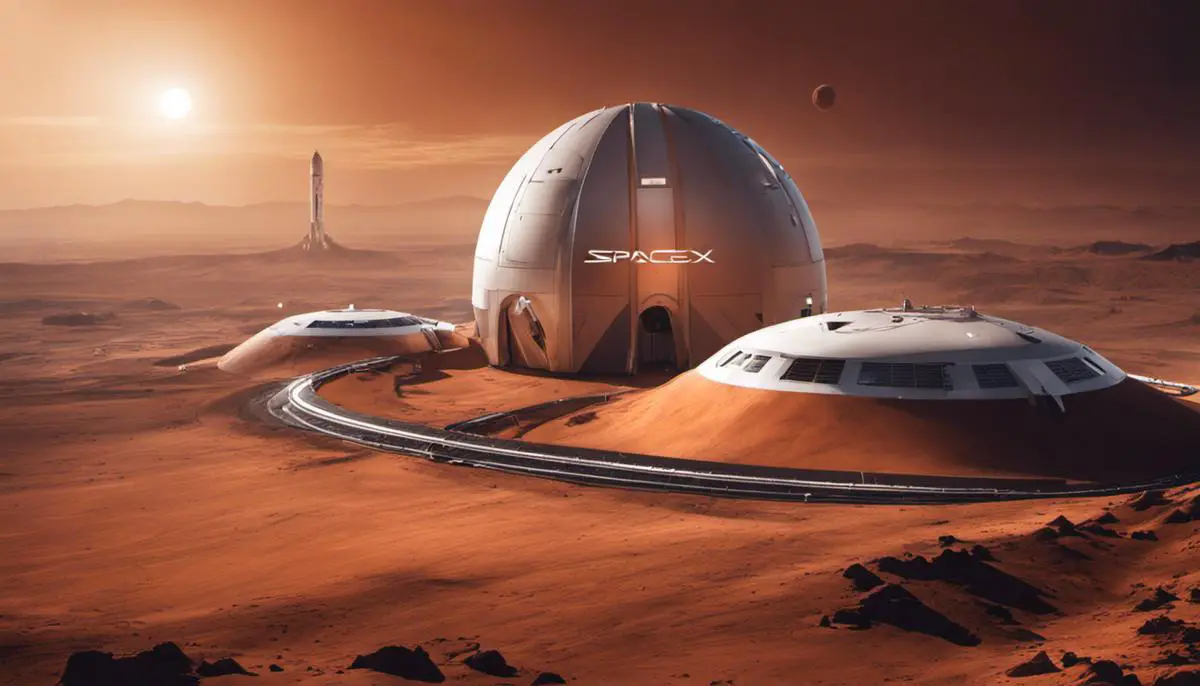Human ingenuity has always sought to stretch the boundaries of the known universe, exploring and conquering new frontiers beyond Earth’s realm. Among the pioneers of this insatiable quest is SpaceX, the private aerospace manufacturer and space transport services company spearheaded by visionary Elon Musk. His ambition to colonize Mars, a dream that once seemed distant and fantastical, is steadily transforming into a plausible reality as his team tirelessly engineers sophisticated spacecrafts and robust rocket systems. This overview will delve into the foundational narratives and far-reaching visions of SpaceX, illuminate the technical intricacies of spacecrafts like the Falcon Heavy and Starship, lay bare the chronological journey of the Mars mission, grapple with the challenges and potential solutions of human habitation on Mars, and finally ponder upon the profound impacts of this monumental feat of Mars colonization.
SpaceX and Its Vision for Mars
SpaceX: Creation and Vision
SpaceX, or Space Exploration Technologies Corp., is an American aerospace manufacturer and space transportation company founded in 2002 by tech entrepreneur Elon Musk. With earlier stands in the tech industry through PayPal and Tesla, Musk turned his entrepreneurial spirit skyward with the goal of reducing space transportation costs to enable the colonization of Mars. SpaceX’s vision is not just about visiting Mars, but making life multiplanetary, shooting for a future where humans live on more than one planetary body.
Elon Musk’s Ambition for Mars
Musk’s profound interest in Mars began with a concept called “Mars Oasis,” aiming to send a small experimental greenhouse to Mars. Musk’s vision significantly expanded over the years, and he has since talked of a future where humans live in a self-sustaining city on Mars. His ambition is rooted in a belief that for humanity to survive, we need to be a multiplanet species. He aims to create a backup plan for human civilization in case of an unthinkable calamity on Earth.
SpaceX Mars Travel Planning: The Starship Project
To achieve this monumental task, SpaceX has been developing a fully reusable spacecraft known as Starship. Unlike anything previously seen, Starship is designed to carry large numbers of passengers beyond Earth’s atmosphere, with an ultimate destination of Mars. SpaceX envisions fleets of these Starship spacecraft embarking on voyages to Mars, shuttling colonists and supplies on a regular schedule to and from the Red Planet.
SpaceX Progress toward Mars Colonization
SpaceX has already made significant strides towards its Mars aspirations. The company has launched increasingly powerful rockets, developed and refined spacecraft, and has landed many of their rockets back on Earth after their missions – a revolutionary feat that is central to their plan to make space travel more affordable. SpaceX was also the first privately-funded company to send a spacecraft (Dragon) to the International Space Station (ISS) in 2012.
Challenges and Next Steps
While the vision is grand, it does not come without significant challenges. The journey to Mars is dangerous, with threats from radiation, microgravity, and the thin Martian atmosphere. SpaceX must ensure they can create life support systems capable of sustained operation for the years-long trips between Earth and Mars. Musk himself acknowledges there are significant hurdles, but he and his company SpaceX remain undeterred and committed to their visionary task.
Despite the daunting challenges, SpaceX is already planning unmanned missions to Mars as early as 2024, with manned missions to follow shortly after. According to Musk, the timeline aims to get a colony up and running on Mars around 2050, which would fulfill Musk’s dream of making life multiplanetary and creating a Plan B for humanity.
SpaceX is constantly testing and perfecting their flagship craft, the Starship, enhancing its capabilities in ascending into and descending back to the Earth. In addition, they are fostering partnerships with NASA as well as other international space agencies as part of SpaceX’s master plan for a Mars mission. The purpose of these collaborations is to share knowledge and resources, a critical factor for SpaceX in achieving their ambitious Mars vision.
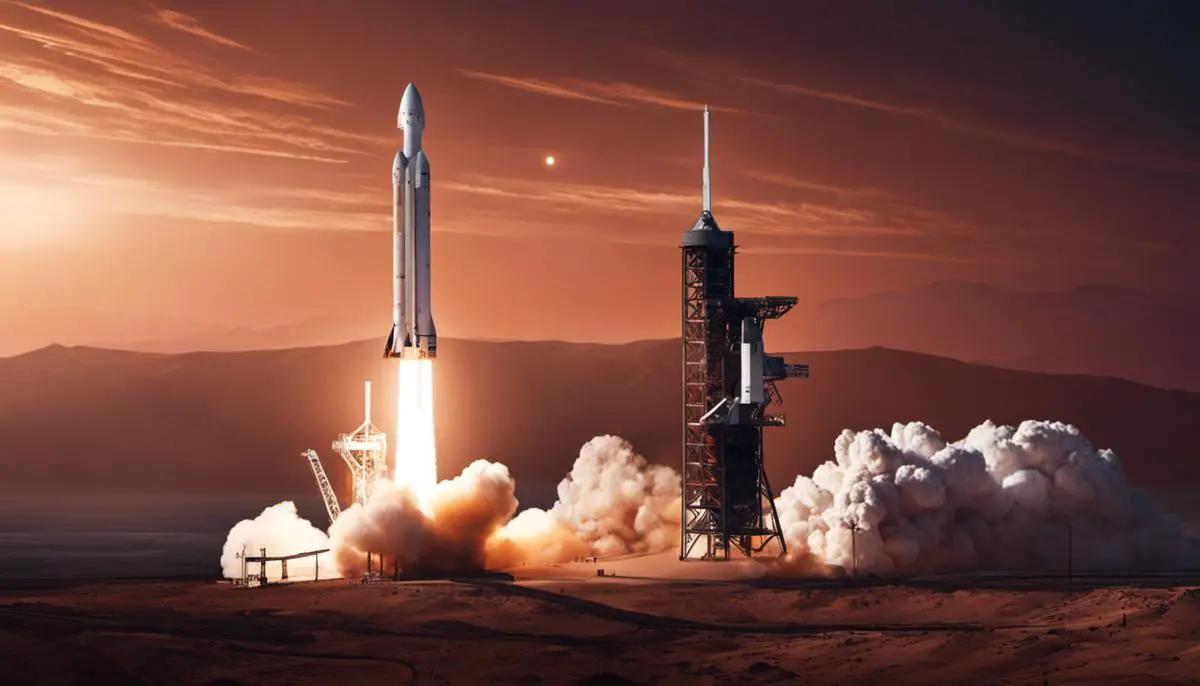
Technical Specifications of SpaceX Mars Mission
Introducing the SpaceX Falcon Heavy Rocket
One of SpaceX’s key assets in their quest for Mars is the Falcon Heavy rocket, a reusable super-heavy launch vehicle built to transport both humans and cargo to Mars. At a towering height of 70 meters and a diameter of 3.66 meters, the Falcon Heavy is essentially equivalent to three Falcon 9 rockets integrated together. This triple-rocket configuration affords it the ability to carry even more significant payloads into orbit. The maximum load it can bear to low Earth orbit is 140,660 pounds (63,800 kilograms) and to Mars, it is 37,040 pounds (16,800 kilograms).
With 27 first-stage Merlin engines, Falcon Heavy exercises a tremendous lift-off thrust of five million pounds, which equals the power generated by eighteen 747 aircraft. Thus, it surpasses the lifting capacity of NASA’s Saturn V, claiming the title of the most powerful functional rocket on the globe. In its design and engineering, Falcon Heavy focuses on safety and reliability, embedding numerous safety mechanisms to manage any engine failures during the mission.
Starship Spacecraft
Starship is SpaceX’s fully reusable spacecraft designed to transport up to 100 people to Mars. With a height of 50 meters (including its conical nose) and a diameter of 9 meters, Starship incorporates a stainless-steel structure, chosen for its strength, durability, and resistance to the harsh environment of space and the Martian atmosphere.
The spacecraft is equipped with six Raptor rocket engines, three for use at sea level and three for use in the vacuum of space. Moreover, Starship features a unique heat shield designed to withstand multiple re-entries into Earth’s atmosphere.
Onboard, Starship provides private cabins, large common areas, centralized storage, solar storm shelters, and a viewing gallery for passengers. These features are designed for long-duration missions such as a Mars expedition.
Preparation for Mars: Adapting to Martian Climate and Atmosphere
SpaceX has built Falcon Heavy and Starship to withstand the harsh environment on Mars. The atmosphere on Mars is much thinner than that of Earth, presenting several unique challenges for landing. SpaceX has proposed the use of a method called supersonic retro propulsion to overcome this difficulty, in which the spacecraft’s rocket engines will be ignited during its descent. This will slow down the spacecraft, enabling a controlled touchdown.
In addition to this, the cold and semi-ionized atmosphere of Mars necessitates the use of spacecraft materials that can resist extreme thermal and chemical conditions. The solution lies in Starship’s stainless-steel structure which is designed to withstand such situations. The Falcon Heavy’s Merlin and Starship’s Raptor engines are crafted to support multiple ignitions, making it possible for them to descend on Mars, ascend back to Earth, and be reusable.
Once on Mars, the mission will rely on solar panels and potentially a nuclear power system to generate energy and refuel the spacecraft for its return journey. The key resources, methane (CH4) and oxygen (O2), will be extracted from the CO2-rich Martian atmosphere and subsurface ice. This process, known as in-situ resource utilization, is critical for long-term space expeditions and sustainability.
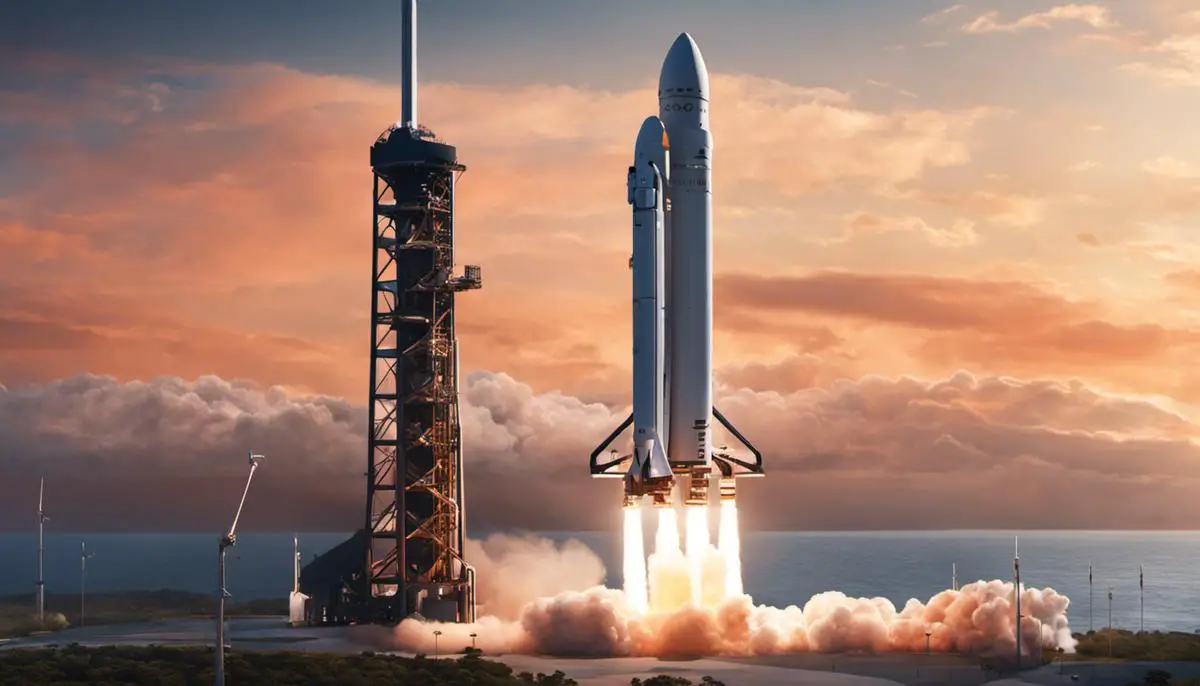
The Mars Mission Timeline
SpaceX and Mars: A Comprehensive Overview
Created by Elon Musk, the brains behind SpaceX, the Mars mission is an ambitious multi-million dollar project. The vision for exploring Mars started to take shape with the establishment of SpaceX in 2002. The driving aim: convert humans into a species that could thrive on more than just one planet.
Milestones: From Falcon Heavy to Starship
The first milestone in SpaceX journey to Mars was set when they successfully launched the Falcon Heavy, the world’s most powerful operational rocket, in February 2018. This rocket is capable of carrying heavy payloads to Mars. Its maiden voyage demonstrated its ability, where it put a Tesla Roadster car into orbit around the sun. In March 2019, its first commercial mission was executed, dispatching a Saudi Arabian communications satellite into the Earth’s orbit.
SpaceX has also successfully developed and tested a series of Starship prototypes. Starship, as Musk envisions, will be the backbone of SpaceX’s Mars landing. This fully reusable rocket, currently under development, is the world’s tallest one and designed to carry humans and 100 tons of cargo to Mars.
Planned Mars Missions: From Timeline to Objectives
The journey to Mars involves multiple phases and well-planned timelines. SpaceX has a flexible launch window that takes into consideration Earth’s and Mars’ orbits alignment, which occurs approximately every 26 months.
The timeline set by Musk intends to place uncrewed SpaceX Starships on Mars as early as 2024, followed by a manned mission around 2026. However, this timeline is considered ambitious by space experts and may have possible adjustments.
The main objectives of the Mars mission includes confirming water resources, identifying hazards, and installing initial power, mining, and life support infrastructure. SpaceX also aims to build a propellant production plant on Mars to enable the return journey to Earth.
Flight Time and Landing Procedures
The flight time to Mars with SpaceX’s Starship could span between three to six months, depending on the speed of the launch and the relative positions of Earth and Mars. The Starship’s landing procedure is designed as a propulsive vertical landing – a method where the rockets are ignited to slow down the spacecraft and permit a vertical landing.
The Starship will employ a heat shield for reentry and aims to land on the Martian surface using its six landing legs. SpaceX’s past experiences with propulsive landings – the Falcon 9 and Falcon Heavy boosters – have guided the Mars landing designs.
The landing site selection is yet to be finalized, but it is likely to be in Mars northern hemisphere, where it is hypothesized to contain substantial quantities of water-ice; a crucial resource for human survival and propellant production.
The pursuit of SpaceX to reach Mars is an audacious aspiration that could potentially change the track of human existence, propelling us into a multi-planetary species. It’s a mission packed with numerous obstacles but also bears the capacity to redefine our perception of life, space, and our role in the cosmos. Every achievement brings SpaceX closer to their Mars goal, transforming the ideas of science fiction into tangible scientific reality.
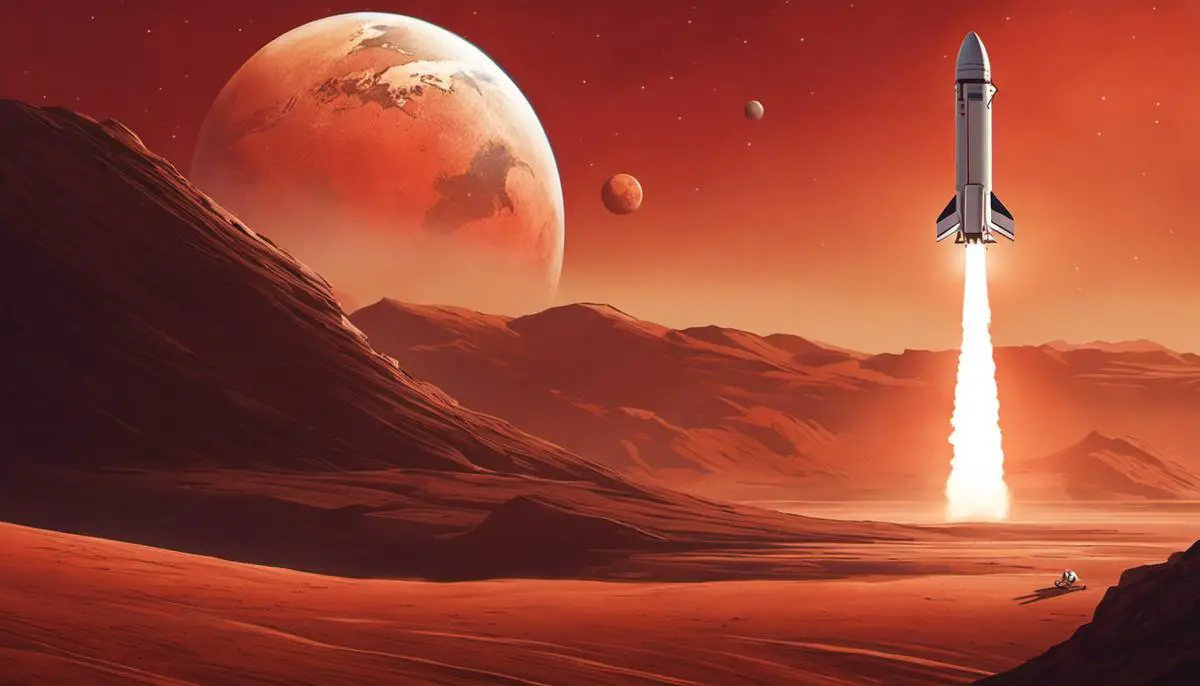
Challenges and Solutions for Living on Mars
Addressing Issues of Radiation Exposure
One of the significant hurdles for human habitation on Mars is the heightened exposure to radiation. Mars does not have the protection of a global magnetic field like Earth and its thin atmosphere also offers little coverage against solar and cosmic radiation. Long-term exposure to this potent radiation could lead to severe health issues, including cancer. In order to mitigate this risk, SpaceX’s strategy includes the use of heavy armor on habitats and vehicles. The shields are proposed to be formed from Mars-specific resources, such as the Martian soil or ‘regolith’, which can absorb substantial quantities of radiation.Low Gravity and Its Effects
Another significant challenge on Mars is coping with its low gravity, roughly 38% of Earth’s gravity. Extended exposure to low gravity can lead to muscle atrophy, bone density loss, cardiovascular problems, and vision impairment. To mitigate these effects, SpaceX plans to incorporate regular exercise and potentially artificial gravity in their Mars habitat design. The spacecraft’s journey to Mars may involve a spinning motion to create centrifugal force, translating into a kind of artificial gravity for the crew.Resource Acquisition on Mars
To create a sustainable settlement, humans will have to harness Mars’ resources. SpaceX’s plan to ‘live off the land’ involves mining water ice at the poles or in subsurface deposits, and breaking it down to produce rocket fuel (hydrogen) and oxygen. This solutions for refueling, sustenance, and creating breathable air are part of SpaceX’s In-Situ Resource Utilization (ISRU) strategy.Starship: The Gateway to Mars
The centerpiece of SpaceX’s Mars colonization plan is the Starship, a fully reusable spacecraft that can carry up to 100 people. Starship is designed to withstand the extreme conditions of interplanetary travel and landing on Mars. The stainless-steel structure of the Starship reduces degradation due to radiation exposure and provides thermal resistance during the entry.Terraforming Mars
In the long-term, SpaceX Founder Elon Musk has proposed terraforming Mars, or making it Earth-like, by warming the planet to release CO2 trapped in the soil and polar ice caps. However, this concept is currently under scientific debate, with several questions about its feasibility and ethical implications.Challenges in Agricultural Development
Food production on Mars poses another set of challenges due to the planet’s soil, which is deficient in the nutrients found in Earth’s soil and contains toxic perchlorates. SpaceX envisages indoor farming, using hydroponics and aeroponics to grow food in nutrient solutions without soil.SpaceX’s plan for a Mars landing is far from a simple feat. It is a monumental step towards a future where human life extends beyond just Earth, offering a safeguard for our species in case an unthinkable catastrophe befalls our planet. Despite the numerous challenges, technologies are being constantly honed and put through rigorous testing, edging us closer to the once fantastical idea of a human settlement on Mars.
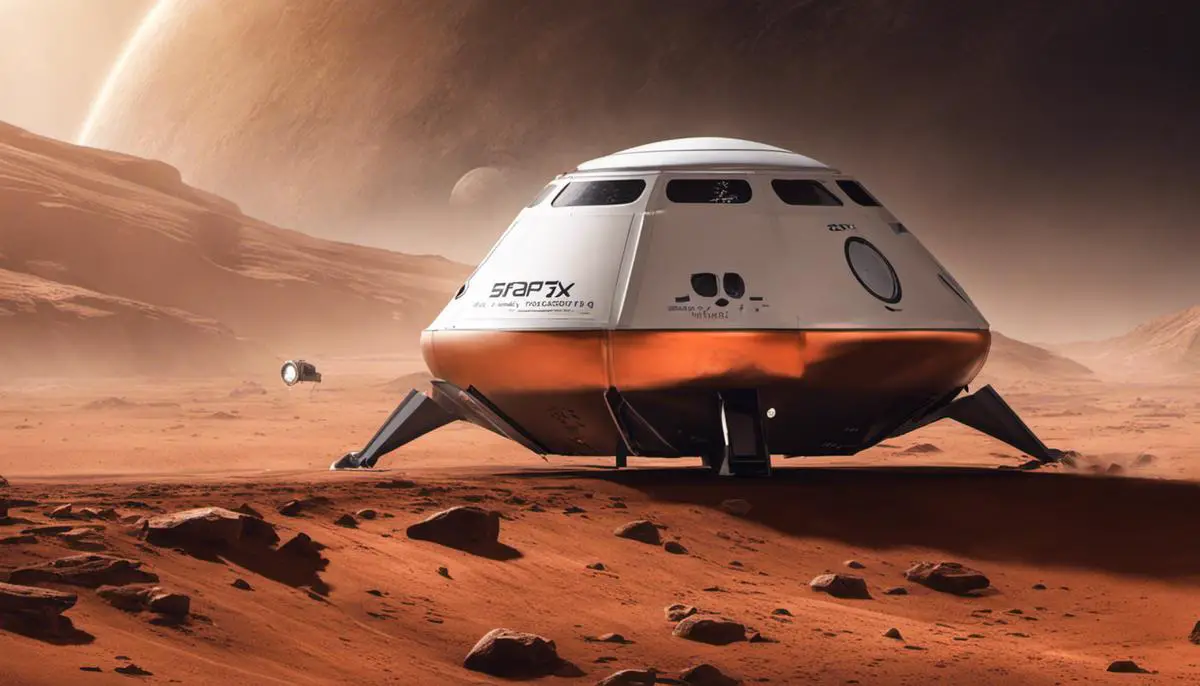
Impacts and Implications of Mars Colonization
Delving Deeper into the Ambition of SpaceX Mars Landing: A Safe Haven and a New Horizon for Discovery
One of the fundamental goals of the SpaceX Mars mission is to eventually establish a human colony on the Red planet. This isn’t just a grand vision of human colonization but also a strategic local escape plan ensuring the survival of life on Earth in the event of a catastrophic incident. A successful landing on Mars could signify an invaluable stride towards preserving not just human life, but also a myriad array of biodiversity.
In terms of scientific advancement, the possibility of colonizing Mars opens up vast new frontiers. Deep study of the Martian surface and what lies beneath could provide invaluable data, helping us to understand and reconstruct the past of our neighboring planet while potentially providing lessons for Earth’s own future. Moreover, the added chances of finding ancient life remains on Mars could lend further clarity to our understanding of Earth’s own life evolution trajectories.
The Ethical Implications of Mars Colonization
The ethical implications of colonizing Mars must be carefully considered. As part of SpaceX’s ambitious plans, should humans change the climate of Mars intentionally in what is known as “terraforming” to make it more Earth-like, it could spark a debate on morality and fairness. Should we have the jurisdiction to intentionally modify the environment of another planet? These are questions that will need further discussion as the Mars project progresses.
Potential Societal Changes with Mars Colonization
SpaceX’s Mars landing could also lead to shifts in how society functions. The establishment of a new society on Mars would involve formulating a set of rules and laws for peace and cooperation. These laws could reflect those of Earthly nations or they could be designed entirely from scratch to better suit the needs of a Martian settlement. The societal shifts could also expand our concept and practice of democracy, introducing a more universal form of it.
Environmental Concerns of SpaceX Mars Landing
The environmental implications of SpaceX’s Mars mission are dual-faced. On one hand, the development of reusable rockets is a breakthrough in reducing the environmental impact of space travel. However, launching rockets could contribute to atmospheric pollution. Idealistically, the spreading of life from Earth could lead to the greening of Mars, yet, it would also lead to the eradication of Mars’ existing environment.
Economic Impact of Mars Colonization
Finally, Mars colonization, as buoyed by SpaceX’s efforts, could reshape global economic structures. The undertaking of space travel and Mars colonization could spur technological development, driving economic growth, and creating new industries. Trade between Earth and Mars could also shuffle power dynamics on Earth, leading to a new era of interplanetary economics.
All these implications underpin the complexity and magnitude of Mars colonization. It represents a leap for mankind that transcends routine living and the boundaries of our current existence. The impact of this undertaking cannot be overstated, and it has the potential to redefine humanity in ways we can only begin to imagine.
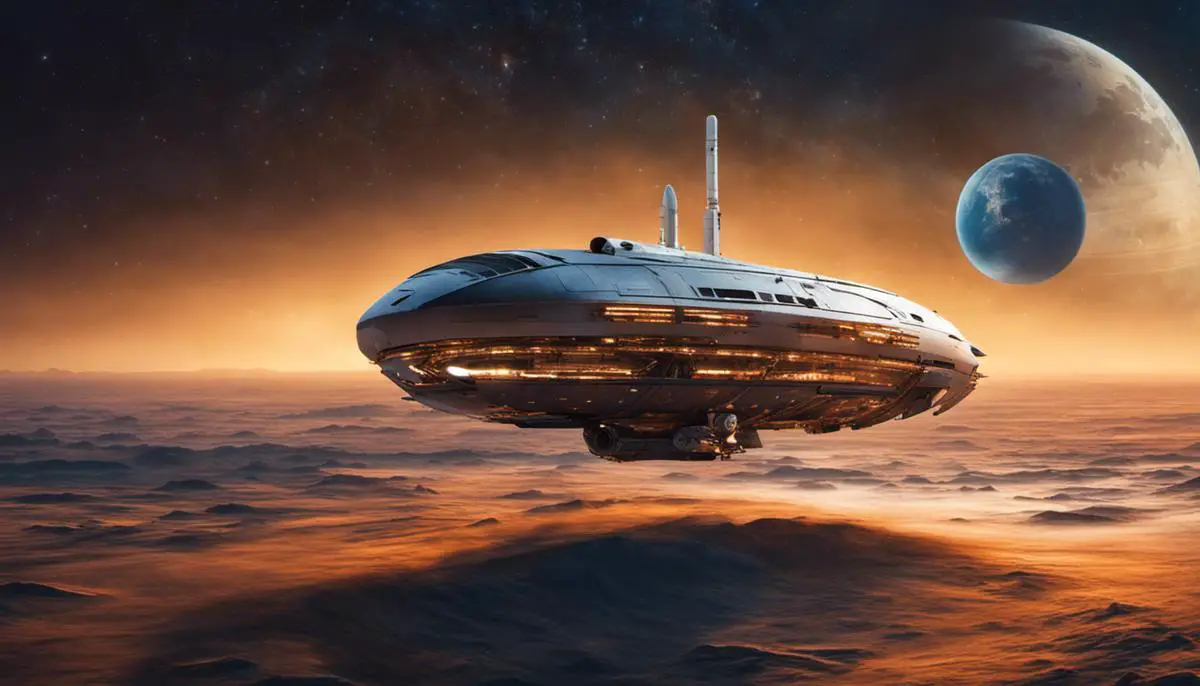
SpaceX’s audacious dream of colonizing Mars is the epitome of human aspiration, pushing the limits of our potential and pioneering a new chapter in space exploration. However, as we stand on the brink of this novel epoch, it’s vital to deliberate on the consequential impacts that this strategic evolution could have on Earth and its inhabitants. Mars colonization signifies not merely a scientific breakthrough, but also carries implications of profound ethical, societal, and environmental significance. It poses a tantalizing opportunity for unlocking new dimensions of knowledge, ensuring our species’ preservation, and feasibly providing solutions to earthbound crises. Yet, it also carries the potential for unforeseen repercussions that we must fully comprehend and strategically circumvent. As we embark on this cosmic voyage, let’s continue to assess, learn, and adapt to ensure the brightest possible future for humans, both on Mars and Earth.
![]()
